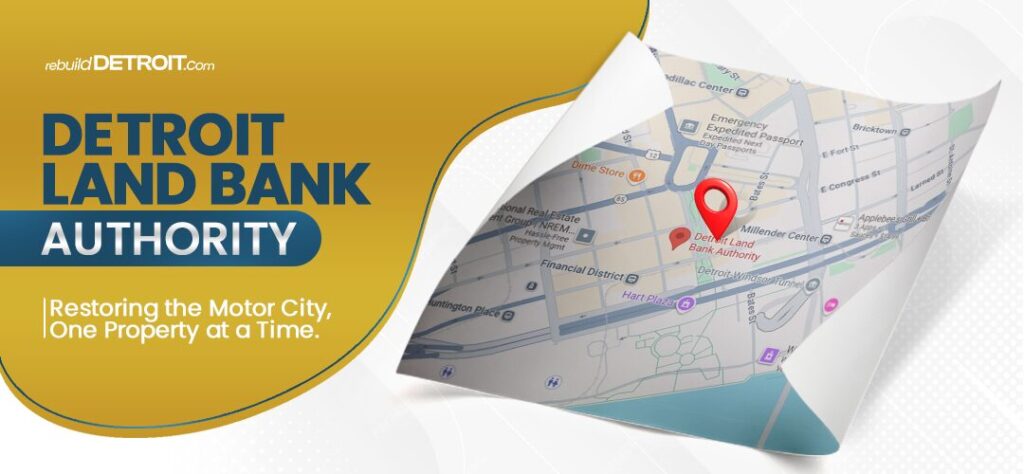
The Detroit Land Bank Authority (DLBA) is a renewal-focused public entity established in 2008 that exists right at the intersection of Detroit’s ongoing struggle and its hope for a brighter tomorrow.
The DLBA operates the largest land bank in the United States and has played a significant role in Detroit’s empowerment since its 2013 bankruptcy as the holder of tens of thousands of parcels (most of which are vacant lots and abandoned homes).
It is one of the city’s top resources to combat blight, promote private homeownership, and foster reinvestment in heavily disinvested neighborhoods.
The Mission
DLBA’s main purpose is to take Detroit’s vacant, abandoned, and foreclosed properties and restore them so that they can be used in a productive manner again.
That said, the implications associated with that mission are surprisingly complex due to the fact that Detroit’s housing stock has become significantly hollowed out since its Motor City boom period. White flight, population decline, and deindustrialization all played a hand in that, and today the DLBA holds the legal title to more than 75,000 parcels of land (about 20% of the entire city of Detroit’s land area) in the face of that.
Michigan’s Public Act 258 and the DBLA’s Core Programs
DBLA got its start under Michigan’s Public Act 258 of 2003.
Since it operates through both state statute and municipal partnership, it’s able to clear titles, forgive back taxes, and quickly sell off properties without the hiccups that typically come along with traditional real estate market mechanisms.
DLBA’s work is centered around four primary channels:
- Own It Now
Own It Now is a fixed-price listing real estate platform offering properties for immediate purchase on a first-come, first-served basis. It’s a program that mainly appeals to buyers who are ready to act quickly and do not want to wait for an auction to secure a property. - Occupied Buy Back
The Occupied Buy Back Program exists for current occupants of foreclosed homes to purchase their homes back at a low cost, typically with the assistance and support of various local housing counseling organizations centered around blight prevention. - Auctions
The online auction platform allows prospective homeowners and investors to bid on vacant homes, especially in neighborhoods where properties typically get ignored. The starting price is usually around $1,000, and all auctions require buyers to bring the home up to code within six months of purchase. - Side Lots
Side lot is a popular program that allows homeowners to purchase adjacent vacant lots for as low as $100–$250, which provides them with the opportunity to expand their yards and create thriving community gardens and gathering spaces. It’s a clever blight solution that stabilizes disenfranchised blocks and rewards those who wish to help save them.
Controversies and Pushback
Like any public entity, DLBA has faced its fair share of scrutiny, investigations, and criticism despite its commendable mission:
- Demolition Contract Issues: Inflated costs, poor oversight, and no-bid contracts during demolitions have led to federal investigations, especially during the peak demolition years following the city’s bankruptcy.
- Transparency Double Standards: Over the years, many have alleged that the auction process favors out-of-state speculators and investors over long-time Detroit residents. It’s also been alleged that shell companies are able to manipulate the bidding process.
- Gentrification: As much as the Land Bank prioritizes owner-occupants and community-based development, many native Detroiters still worry that their work is a prelude to displacement.
Neighborhood Revitalization Impact
All worries aside, DLBA has been a mostly positive force in Detroit’s fight for renewal, stabilization, and growth.
By fixing titles and consolidating land under public control, the Land Bank has become a vital resource in the city’s coordinated renovation efforts.
Restored Land Bank homes in neighborhoods like Bagley, Boston-Edison, and East English Village have brought entire blocks back to life, attracting new homeowners and helping to restore the city’s tax revenue in a major way.
Another major plus is the fact that many DLBA lots have been used to construct community gardens, urban farms, art installations, green infrastructure projects, and even parks.
Look no further than projects like the Fitzgerald Revitalization Project, where the Land Bank took abandoned homes and vacant lots and turned them into lush parks and gardens.
Looking Forward
Detroit Land Bank Authority’s future is still in flux.
Detroit’s real estate market is only just beginning to heat up, which means the Land Bank is now facing an entirely new challenge: ensuring that development remains local, equitable, and accessible to all.
In short: In a city as deeply scarred yet spirited as Detroit, there is no perfect formula—only dedicated entities such as the Detroit Land Bank Authority that are slowly chipping away at decades of decline.
It’s far from a cure-all, yet it remains one of the most powerful avenues of urban transformation in the city today.


 Please check your email for your login details.
Please check your email for your login details.